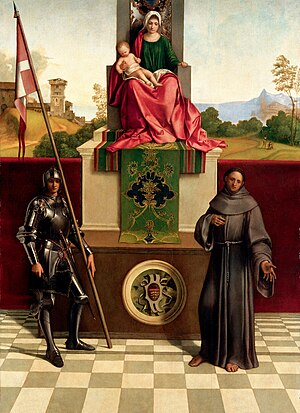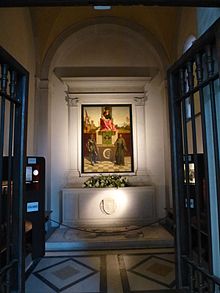Pala di Castelfranco

|
| Madonna and Child between St. Francis and Nicasius |
|---|
| Giorgione , 1503/04 |
| Oil on poplar wood |
| 200.5 x 144.5 cm |
| Castelfranco Cathedral |
The Madonna and Child between St. Francis and Nicasius , also known as Castelfranco Madonna , is an Italian Renaissance painting from 1503 by Giorgione . It is one of the few works by the painter from Castelfranco in Veneto , northern Italy , who died of the consequences of the plague at the age of 32. It is located in Castelfranco Cathedral .
history
The picture is one of the few works in which the origin of Giorgione is certain. The order for the altarpiece was commissioned by the condottiere Tuzio Costanzo, son of the Viceroy of Cyprus , in memory of his son Matteo, who died of a fever in Ravenna in 1499 at the age of 23 in the service of the Republic of Venice . Tuzio also commissioned the construction of a family chapel for the funerary monuments of Matteo and himself originally on the walls on both sides of the painting. In the period that followed, the previous church was demolished and the current Cathedral of Castelfranco was built in its place in 1724 . The new church building has a small chapel to the right of the presbytery , in which the painting and directly below Matteo's grave with his relief are located. The Costanzo coat of arms, three pairs of ribs, can be seen on the grave monument at the foot of the Madonna's throne. (Some of Giorgione's disciples claimed that St. Nicasius was a portrait of Matteo).
Bad restorations have taken place over the past few centuries and on December 10, 1972 the painting was stolen. After its recovery, it was carefully restored in the workshops of the Accademia (Venice) from 2002–2003 and shown in the exhibition Le maraviglie dell'arte before it returned to Castelfranco in December 2005 .
description
The painting is a Sacra Conversazione , which here is reduced to three people who do not form a closed group. It shows the enthroned Madonna and Child and St. Francis of Assisi (right) and Nicasius (left). The depicted are arranged in a pyramid shape. The saint in armor used to be regarded as saint George or saint liberalis, patron saint of Castelfranco. Matteo and his brother Brutto Muzio were members of the Order of Malta , whose standard St. Nicasius bears. The martyr Nicasius, who also belonged to the Order of Malta, died in 1187. He was especially venerated in Messina , the birthplace of Tuzio Costanzo. The waiver of any reference to church motive conventions and solemnity should be emphasized. The three people are formally separated from each other, each lost in itself. In the intimate and meditative room, the two saints stand for bravery (Nicasius) and piety (Francis), and turn their gaze to the devout observer. The saint in armor and the destroyed towers of the city above him tell of war, the bringer of pain and death. Giorgione thus breaks away from the traditional arrangement of images . The throne of Mary rises, emphasizing the central axis of the picture, unnaturally high above the space allocated to St. Francis and Nicasius in the landscape, which takes up a good part of the background. The architectural space merges directly into nature. The colors of the structure of the throne, the green of which stands out well against the dark red background, increase in fine gradations. The lighter landscape green adapts to the lighter red and dark green of Maria’s robe (instead of the traditional blue) and creates a spatial unity of interior and landscape. The red velvet curtain separates the two levels of the composition, the landscape of human life, to which Mary and God's Son also belong, and the sacred area at the foot of the Marian throne. Mary and child look sad and deeply grieved to the sarcophagus of porphyry , the symbolic grave with crest Costanzo, thus connecting the two image planes. The linear perspective construction space of the early Renaissance is abandoned here, but is still used in the perspective arrangement of the floor.
reception
The pictorial technique is an example of what Vasari called pittura senza disegno (painting without a draft). This new approach to painting revolutionized the Venetian school of painting and became famous with the painting La tempesta (The Thunderstorm) . Titian , a pupil of Giorgione , later became the most famous exponent of this style. The depiction of St. Francis of Assisi is very similar to that in Giovanni Bellini's San Giobbes Altarpiece (c. 1487) - in a mirror image position.
literature
- Giorgione: la Pala di Castelfranco Veneto . Catalog of the exhibition in Castelfranco Veneto, May 29th – September 30th 1978. Ed. Lorenzo Lazzarini.
- Gabriella Delphini in Castelfranco Veneto, The Town of Giorgione, 2008 Biblos
- L. Comacchio: Splendore di Asolo ai tempi della Regina Cornaro . Castelfranco Veneto 1969.
- Reclam's art guide. Northern Italy East . Arranged by Erich Egg , Erich Hubala u. a. Stuttgart 1965. pp. 119-120.
Web links
- Castelfranco Veneto: La pala di Giorgione
- Museo Casa Giorgione
- Museo del Prado Giorgione - Titian
- gettyimages
- The Getty Center: Interim Results of a Needs Assessment Survey for the Field of Panel Paintings Conservation (pdf; English, p. 54)
Individual evidence
- ↑ a b Sergia Jessi: Pittura senza disegno, so cambiò la storia dell'arte moderna [1] (December 11, 2011, Italian, accessed on July 28, 2014)
- ↑ Albert Boesten, On the connection between style and meaning in Giorgione's painting, dissertation Freiburg 1987, pages 11, 57, 60 (pdf; 2.2MB)
- ^ Exhibition of the Kunsthistorisches Museum
